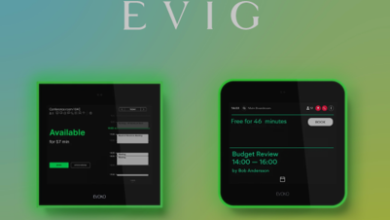Integrating Android Barcode Scanners with IoT for Smarter Operations

Introduction to IoT and Barcode Scanning
The Internet of Things (IoT) is a growing network of interconnected devices that collect, exchange, and analyze data in real-time. These devices range from simple consumer products to complex industrial sensors, and they are transforming industries by changing how data is collected and processed.
Barcode scanning, a long-standing technology for identifying and tracking products, is becoming increasingly integrated with IoT systems. This combination leads to smarter and more efficient operations across various industries.
AI-powered barcode scanners are key to this integration. These scanners use machine learning and artificial intelligence to do more than just read barcodes. When connected to IoT networks, they collect, analyze, and share real-time data, helping businesses streamline operations and automate processes. This synergy enables better inventory management, product tracking, and control over logistics and supply chains.
AI-Powered Barcode Scanners in IoT Ecosystems
Barcode scanners have been essential for supply chain management and inventory tracking for decades. With the rise of IoT, these scanners have evolved from simple data-capture devices into integral components of intelligent systems. IoT integration allows barcode scanners to interact with various smart devices, such as inventory management systems, sensors, and control units, enabling businesses to automate and optimize processes.
An AI-powered barcode scanner uses algorithms and machine learning to interpret data. It can recognize patterns, make predictions, and adapt based on environmental conditions. When incorporated into an IoT ecosystem, such a scanner can identify a product, track its journey through the supply chain, predict demand, monitor condition, and trigger actions based on predefined parameters.
For example, when an item is scanned at a warehouse or retail location, the scanner can automatically relay information about the product’s identity, its location within the facility, and its status to an IoT-enabled inventory system. If the item is part of a smart shelf with sensors, the scanner can also detect the shelf’s capacity and alert the system if restocking is required. This communication between devices allows for seamless data flow and provides businesses with real-time visibility into their operations.
See also: How Modern Cleaning Technology is Revolutionizing Home Maintenance
Automated Inventory Management in IoT-enabled Environments
One of the significant applications of IoT-enabled barcode scanning is in inventory management, where automation can drastically improve efficiency and accuracy. Traditional warehouses rely on manual stock checks, barcode scanning, and oversight to track inventory levels. This process is time-consuming, prone to errors, and lacks real-time visibility. By integrating barcode scanning with IoT technology, warehouses and retail environments can achieve automated inventory management, where stock levels, item locations, and reordering processes are managed autonomously.
AI-powered barcode scanners enable this integration by providing real-time data about scanned products, which is then communicated to IoT-connected systems for further processing.
Real-Time Stock Monitoring and Data Synchronization
In an IoT-enabled inventory management system, barcode scanners can track the movement of items in real-time. When a product is scanned, the barcode scanner communicates with an IoT system that updates the inventory database immediately, ensuring accurate and synchronized stock counts across the system.
If an item is moved, scanned, or sold, the barcode scanner sends a signal to the network, adjusting stock levels accordingly. For example, consider a scenario where a product is moved from one shelf to another within a warehouse. An IoT-enabled shelf could have built-in sensors that communicate with the barcode scanner, notifying the system of the item’s new location. This not only helps with inventory tracking but also enables businesses to optimize storage space and layout based on real-time data.
Smart Reordering and Predictive Stock Management
In addition to tracking stock levels, AI-powered barcode scanners can help automate the reordering process. Once integrated with an IoT-enabled inventory management system, these scanners can trigger restocking actions based on predefined parameters, such as minimum stock thresholds or predicted demand.
For instance, if a barcode scanner detects that a product is running low, it can send a signal to the IoT system to automatically generate a reorder request. Additionally, AI-powered systems can predict future demand for specific products based on historical data and trends, ensuring that businesses maintain optimal stock levels and avoid stockouts.
Efficient Shelf Space Management
One of the more advanced applications of AI-powered barcode scanners in IoT environments is the optimization of shelf space. Maximizing shelf space is crucial for maintaining efficiency and reducing operational costs in large warehouses or retail stores.
Through IoT sensors embedded in shelves, barcode scanners can identify available space and help determine the best arrangement for products based on factors such as product size, weight, and demand. This approach allows businesses to adjust their shelving layouts dynamically, improving product accessibility and reducing unnecessary restocking. Additionally, AI-powered systems can analyze product turnover and suggest placement changes to improve overall warehouse flow.
Smart Labels and Sensor-Embedded Barcodes
In recent years, the concept of smart labels has gained traction in various industries. Smart labels, typically equipped with embedded sensors and wireless communication capabilities, can provide much more data than traditional barcodes. These labels can track additional parameters such as temperature, humidity, location, and even the condition of the product during transit.
When combined with AI-powered barcode scanners and IoT networks, smart labels enhance the traceability and monitoring capabilities of products, particularly in industries such as pharmaceuticals, logistics, and food safety.
Beyond Product Identity: Tracking Conditions and Environmental Factors
Traditional barcodes primarily contain information about a product’s identity, such as its SKU, price, and manufacturer. In contrast, smart labels equipped with sensors can collect and transmit real-time data on a variety of factors that affect a product’s quality or safety.
For example, in the pharmaceutical industry, smart labels could monitor the temperature of medication shipments, ensuring that sensitive products are kept within required storage conditions throughout the supply chain. When a barcode scanner reads a smart label, it can access not just the product’s identity but also the environmental data stored within the label. This information can be transmitted to an IoT-enabled system, which can alert businesses about potential issues, such as temperature excursions that may compromise product quality.
Improved Traceability and Accountability in Logistics
For industries where product traceability is crucial, such as food safety or pharmaceuticals, smart labels provide an invaluable layer of data. IoT-enabled barcode scanners can read the smart labels on products and provide real-time updates about the product’s condition and location.
This enhanced traceability allows businesses to identify potential issues, such as contamination risks or expired products, and take corrective action before they reach the consumer. For example, in the logistics industry, IoT-enabled barcode scanners can read the smart labels on packages during transit and monitor parameters such as temperature and humidity. If the product is being transported in a refrigerated truck and the temperature rises above a certain threshold, the system can send an immediate alert, allowing for quick intervention.
Optimizing Product Lifecycle Management
In addition to tracking environmental conditions, smart labels can also provide valuable data about the lifecycle of a product. For example, a smart label on a piece of equipment or machinery could record its usage history, maintenance schedule, and service requirements.
AI-powered barcode scanners can read this information and relay it to IoT-based asset management systems, which can trigger maintenance alerts and ensure that equipment is serviced before it fails. This capability is useful in industries such as manufacturing and automotive, where equipment uptime and maintenance scheduling are critical for operational efficiency.
Case Studies and Applications of IoT and Barcode Scanning Integration
The integration of IoT and barcode scanning is transforming various industries, providing significant benefits in terms of efficiency, cost reduction, and enhanced customer experience. These applications demonstrate how this integration is beneficial in different sectors.
Retail and Supply Chain
Retailers are among the early adopters of IoT-enabled barcode scanning systems. By integrating AI-powered barcode scanners with IoT networks, retailers can automate stock management, track product movements, and monitor sales in real-time. Smart shelves with IoT sensors can detect when items are removed or sold, automatically adjusting inventory levels and generating restocking alerts. This not only helps reduce stockouts and overstock situations but also improves the customer shopping experience.
In supply chain management, IoT-enabled barcode scanning systems are helping companies track products from the moment they are manufactured until they reach the consumer. This end-to-end visibility allows businesses to optimize their supply chains, reduce delays, and improve delivery accuracy.
Pharmaceuticals and Healthcare
In the pharmaceutical industry, the integration of barcode scanning with IoT and smart labels has improved the safety and traceability of medications. By scanning smart labels equipped with temperature sensors, pharmaceutical companies can ensure that drugs are stored and transported within the required temperature ranges. Additionally, AI-powered barcode scanners can help track expiration dates, automatically flagging products that are near expiration and ensuring they are used before they become ineffective.
Hospitals and healthcare facilities are also adopting barcode scanning technology to streamline inventory management and improve patient care. By scanning medications, medical supplies, and equipment, healthcare providers can track usage, reduce errors, and ensure that critical items are always available when needed.
Food Safety and Logistics
In the food industry, ensuring the safety and quality of products is important. By integrating IoT-enabled barcode scanning systems with smart labels that monitor temperature, humidity, and other environmental factors, businesses can track the condition of food products throughout the supply chain. If a product is exposed to unsafe conditions, the system can trigger an alert, preventing it from reaching consumers.
IoT-enabled barcode scanners are also helping logistics companies optimize their operations by providing real-time visibility into the location and condition of goods in transit. This helps ensure that products are delivered on time and in the right condition.
Case Study: Walmart’s IoT-Enabled Inventory Management
- Industry: Retail
- Challenge: Inaccurate inventory management and stockouts.
- Solution: Integration of IoT and AI-powered barcode scanning.
Walmart implemented a comprehensive IoT-based solution including AI-powered barcode scanners, smart shelves with sensors and real-time inventory management systems to address frequent stockouts and inaccurate inventory counts.
Walmart’s stores are equipped with smart shelves that are embedded with sensors capable of detecting product levels. AI-powered barcode scanners are used by employees to scan products as they are shelved or purchased, with the real-time data automatically transmitted to the central inventory system. This system tracks the number of items on the shelf, and when stock levels drop below a preset threshold, an automatic reorder process is triggered.
The integration of IoT with barcode scanning has improved Walmart’s inventory accuracy and replenishment processes. In addition to preventing stockouts, the system also reduces overstocking, which decreases storage costs. Walmart reports higher operational efficiency, lower inventory carrying costs, and improved customer satisfaction due to better product availability.
- Outcome:
- Reduced stockouts.
- Improved inventory accuracy.
- Optimized stock replenishment.
- Better product availability for customers.
Case Study: Pfizer’s Temperature Monitoring with IoT-Enabled Barcode Scanners
- Industry: Pharmaceuticals
- Challenge: Ensuring the safe transport and storage of temperature-sensitive medicines.
- Solution: Smart labels, IoT-enabled barcode scanners, and temperature monitoring.
Pfizer integrated IoT-enabled barcode scanning systems with smart labels that include temperature sensors. Each smart label is embedded with a temperature sensor that continuously monitors the conditions of the medication during transport, and the labels are scanned at various points throughout the supply chain using AI-powered barcode scanners. When a package is scanned, the barcode scanner identifies the product and reads the data from the smart label, providing real-time information on the product’s temperature history.
If any product is found to have been exposed to unsafe conditions, the system triggers an alert, notifying the supply chain team to take corrective action before the product reaches customers or patients.
By integrating IoT and barcode scanning, Pfizer improved the safety and traceability of its temperature-sensitive products, ensuring compliance with regulatory requirements and maintaining the integrity of its products.
- Outcome:
- Real-time temperature monitoring and alerts.
- Reduced instances of spoilage or contamination.
- Improved compliance with industry regulations.
- Enhanced traceability for each shipment of temperature-sensitive products.
Case Study: Maersk and the IoT-Enabled Smart Containers
- Industry: Logistics and Shipping
- Challenge: Managing shipping container conditions and locations in real-time.
- Solution: IoT-integrated smart containers and barcode scanning.
Maersk developed smart containers equipped with sensors that monitor variables such as location, temperature, humidity, and vibration, and the smart containers were embedded with barcode labels to facilitate easy identification and tracking through IoT-connected barcode scanners. As the containers move across the shipping process, barcode scanners scan the smart containers to collect data on their current status. This data is transmitted to a central IoT system, where it is analyzed in real-time.
In the event of an anomaly, such as a temperature fluctuation, the system can trigger an alert to Maersk’s operations team. By integrating barcode scanning with IoT-enabled smart containers, Maersk has been able to increase the visibility of its global fleet and reduce the risk of damaged goods.
- Outcome:
- Increased visibility of shipping container conditions and locations.
- Improved real-time decision-making and reduced delays.
- Reduced incidents of cargo damage due to environmental factors.
- Enhanced customer satisfaction with real-time tracking and updates.
Case Study: Domino’s Pizza and the IoT-Enabled Smart Delivery Boxes
- Industry: Food Delivery
- Challenge: Maintaining food quality during delivery.
- Solution: Smart delivery boxes with IoT sensors and barcode scanning.
Domino’s implemented IoT-enabled smart delivery boxes to track the condition of the food while in transit. Each delivery box was equipped with temperature sensors and RFID tags, and Domino’s AI-powered barcode scanners were used to scan the barcodes on the food orders at various stages of the delivery process. The barcode scanners tracked the order and communicated with the IoT sensors to monitor whether the pizza remained within the optimal temperature range.
If the temperature of the pizza fell outside the designated range during transport, the system could send an alert to the delivery driver, which allows Domino’s to optimize delivery routes in real-time. The integration of IoT and barcode scanning in Domino’s delivery process helped improve food quality, reduce customer complaints, and streamline the logistics of food delivery.
- Outcome:
- Ensured better food quality through real-time temperature monitoring.
- Reduced delivery time and improved customer satisfaction.
- Increased operational efficiency with real-time alerts for delivery drivers.
- Enhanced overall customer experience with smarter delivery systems.
Case Study: DHL and the IoT-Enabled Warehouse Automation
- Industry: Logistics and Warehousing
- Challenge: Manual inventory tracking, inefficiency, and human error in warehouses.
- Solution: IoT-connected barcode scanners, drones, and robots for automated warehousing
DHL integrated IoT-powered solutions such as barcode scanners, robotic systems, and drones into its warehouse operations. In the automated warehouse, barcode scanners are connected to an IoT system that tracks inventory in real-time. These scanners are mounted on autonomous mobile robots (AMRs) and drones that roam the warehouse, scanning barcodes on shelves and products as they move. The robots and drones can autonomously fetch items based on barcode scanning and order fulfillment requests.
The integration of IoT-enabled barcode scanning systems has improved the accuracy and efficiency of DHL’s warehousing processes, which allowed the company to handle larger volumes of goods with fewer resources and less manual labor.
- Outcome:
- Increased inventory accuracy.
- Reduced order fulfillment time.
- Streamlined warehouse operations.
- Improved scalability of warehouse operations.
Conclusion
These cases demonstrate the benefits of integrating AI-powered barcode scanning systems with IoT technology across various industries. The combination of IoT and barcode scanning is reshaping how businesses operate and enhances overall efficiency. As IoT technology continues to evolve, we can expect even more innovative solutions that leverage the power of barcode scanning to optimize operations, reduce costs, and improve customer experiences.
What Is an IoT Barcode Scanner?
An IoT barcode scanner performs two tasks: scanning barcodes and connecting to the internet to send data instantly. Traditional scanners use cables to send information to a computer, while IoT scanners use Wi-Fi, Bluetooth, or RFID to communicate directly with cloud systems and other smart devices. This setup allows for live updates, remote monitoring, and seamless integration into IoT networks, streamlining workflows and improving data accessibility.
Integrating IoT Barcode Scanners in Logistics, Warehousing, and Manufacturing
IoT barcode scanners are improving supply chain efficiency across various industries.
Smart Manufacturing Applications
In automotive manufacturing, fixed-position barcode scanners are used at assembly lines to accurately identify direct part marking (DPM) codes on complex components. Paired with 5G networks, these scanners provide live data to Manufacturing Execution Systems (MES), reducing assembly errors and increasing output.
Warehousing Innovations
IoT scanners are transforming warehouses. For example, the iDPRT M2 Plus smart handheld terminal integrates a handheld PDA, barcode scanner (supporting 1D/2D barcodes), and RFID/NFC reading capabilities. With an IP65-rated design for dustproofing, drop resistance, and chemical corrosion protection, this tool enables warehouse staff to seamlessly conduct:
- Real-time inventory tracking via Wi-Fi or 4G.
- Sorting, stock counting, and data verification.
- Instant cloud-based data uploads for synchronized workflows.





